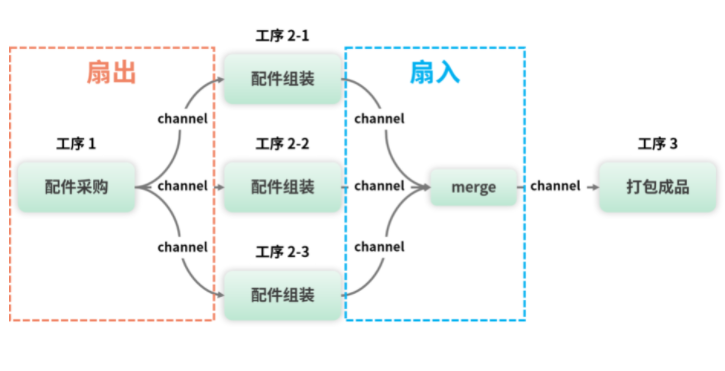Go通关12:如何写出高效的并发模式?
对于并发操作,前面我们已经了解到了 channel 通道、同步原语 sync 包对共享资源加锁、Context 跟踪协程/传参等,这些都是并发编程比较基础的元素,相信你已经有了很好的掌握。今天我们介绍下如何使用这些基础元素组成并发模式,更好的编写并发程序。
for select 无限循环模式
这个模式比较常见,之前文章中的示例也使用过,它一般是和 channel 组合完成任务,格式为:
for { //for 无限循环,或者使用 for range 循环
select {
//通过 channel 控制
case <-done:
return
default:
//执行具体的任务
}
}
- 这种是 for + select 多路复用的并发模式,哪个 case 满足条件就执行对应的分支,直到有满足退出的条件,才会退出循环。
- 没有退出条件满足时,则会一直执行 default 分支
for range select 有限循环模式
for _,s:=range []int{}{
select {
case <-done:
return
case resultCh <- s:
}
- 一般把迭代的内容发送到 channel 上
- done channel 用于退出 for 循环
- resultCh channel 用来接收循环的值,这些值可以通过 resultCh 传递给其他调用者
select timeout 模式
假如一个请求需要访问服务器获取数据,但是可能因为网络问题而迟迟获取不到响应,这时候就需要设置一个超时时间:
package main
import (
"fmt"
"time"
)
func main() {
result := make(chan string)
timeout := time.After(3 * time.Second) //
go func() {
//模拟网络访问
time.Sleep(5 * time.Second)
result <- "服务端结果"
}()
for {
select {
case v := <-result:
fmt.Println(v)
case <-timeout:
fmt.Println("网络访问超时了")
return
default:
fmt.Println("等待...")
time.Sleep(1 * time.Second)
}
}
}
运行结果:
等待...
等待...
等待...
网络访问超时了
- select timeout 模式核心是通过 time.After 函数设置的超时时间,防止因为异常造成 select 语句无限等待
注意:
不要写成这样for { select { case v := <-result: fmt.Println(v) case <-time.After(3 * time.Second): //不要写在 select 里面 fmt.Println("网络访问超时了") return default: fmt.Println("等待...") time.Sleep(1 * time.Second) } }case <- time.After(time.Second) 是本次监听动作的超时时间,意思就说,只有在本次 select 操作中会有效,再次 select 又会重新开始计时,但是有default ,那case 超时操作,肯定执行不到了。
Context 的 WithTimeout 函数超时取消
package main
import (
"context"
"fmt"
"time"
)
func main() {
// 创建一个子节点的context,3秒后自动超时
//ctx, stop := context.WithCancel(context.Background())
ctx, stop := context.WithTimeout(context.Background(), 3*time.Second)
go func() {
worker(ctx, "打工人1")
}()
go func() {
worker(ctx, "打工人2")
}()
time.Sleep(5*time.Second) //工作5秒后休息
stop() //5秒后发出停止指令
fmt.Println("???")
}
func worker(ctx context.Context, name string){
for {
select {
case <- ctx.Done():
fmt.Println("下班咯~~~")
return
default:
fmt.Println(name, "认真摸鱼中,请勿打扰...")
}
time.Sleep(1 * time.Second)
}
}
运行结果:
打工人2 认真摸鱼中,请勿打扰...
打工人1 认真摸鱼中,请勿打扰...
打工人1 认真摸鱼中,请勿打扰...
打工人2 认真摸鱼中,请勿打扰...
打工人2 认真摸鱼中,请勿打扰...
打工人1 认真摸鱼中,请勿打扰...
下班咯~~~
下班咯~~~
//两秒后
???
- 上面示例我们使用了 WithTimeout 函数超时取消,这是比较推荐的一种使用方式
Pipeline 模式
Pipeline 模式也成为流水线模式,模拟现实中的流水线生成。我们以组装手机为例,假设只有三道工序:零件采购、组装、打包成品:
零件采购(工序1)-》组装(工序2)-》打包(工序3)
package main
import (
"fmt"
)
func main() {
coms := buy(10) //采购10套零件
phones := build(coms) //组装10部手机
packs := pack(phones) //打包它们以便售卖
//输出测试,看看效果
for p := range packs {
fmt.Println(p)
}
}
//工序1采购
func buy(n int) <-chan string {
out := make(chan string)
go func() {
defer close(out)
for i := 1; i <= n; i++ {
out <- fmt.Sprint("零件", i)
}
}()
return out
}
//工序2组装
func build(in <-chan string) <-chan string {
out := make(chan string)
go func() {
defer close(out)
for c := range in {
out <- "组装(" + c + ")"
}
}()
return out
}
//工序3打包
func pack(in <-chan string) <-chan string {
out := make(chan string)
go func() {
defer close(out)
for c := range in {
out <- "打包(" + c + ")"
}
}()
return out
}
运行结果:
打包(组装(零件1))
打包(组装(零件2))
打包(组装(零件3))
打包(组装(零件4))
打包(组装(零件5))
打包(组装(零件6))
打包(组装(零件7))
打包(组装(零件8))
打包(组装(零件9))
打包(组装(零件10))
扇入扇出模式
手机流水线运转后,发现配件组装工序比较耗费时间,导致工序1和工序3也相应的慢了下来,为了提升性能,工序2增加了两班人手:

- 根据示意图能看到,红色部分为扇出,蓝色为扇入
改进后的流水线:
package main
import (
"fmt"
"sync"
)
func main() {
coms := buy(10) //采购10套配件
//三班人同时组装100部手机
phones1 := build(coms)
phones2 := build(coms)
phones3 := build(coms)
//汇聚三个channel成一个
phones := merge(phones1,phones2,phones3)
packs := pack(phones) //打包它们以便售卖
//输出测试,看看效果
for p := range packs {
fmt.Println(p)
}
}
//工序1采购
func buy(n int) <-chan string {
out := make(chan string)
go func() {
defer close(out)
for i := 1; i <= n; i++ {
out <- fmt.Sprint("零件", i)
}
}()
return out
}
//工序2组装
func build(in <-chan string) <-chan string {
out := make(chan string)
go func() {
defer close(out)
for c := range in {
out <- "组装(" + c + ")"
}
}()
return out
}
//工序3打包
func pack(in <-chan string) <-chan string {
out := make(chan string)
go func() {
defer close(out)
for c := range in {
out <- "打包(" + c + ")"
}
}()
return out
}
//扇入函数(组件),把多个chanel中的数据发送到一个channel中
func merge(ins ...<-chan string) <-chan string {
var wg sync.WaitGroup
out := make(chan string)
//把一个channel中的数据发送到out中
p:=func(in <-chan string) {
defer wg.Done()
for c := range in {
out <- c
}
}
wg.Add(len(ins))
//扇入,需要启动多个goroutine用于处于多个channel中的数据
for _,cs:=range ins{
go p(cs)
}
//等待所有输入的数据ins处理完,再关闭输出out
go func() {
wg.Wait()
close(out)
}()
return out
}
运行结果:
打包(组装(零件2))
打包(组装(零件3))
打包(组装(零件1))
打包(组装(零件5))
打包(组装(零件7))
打包(组装(零件4))
打包(组装(零件6))
打包(组装(零件8))
打包(组装(零件9))
打包(组装(零件10))
- merge 和业务无关,不能当做一道工序,我们应该把它叫做 组件
- 组件是可以复用的,类似这种扇入工序,都可以使用 merge 组件
Futures 模式
Pipeline 流水线模式中的工序是相互依赖的,只有上一道工序完成,下一道工序才能开始。但是有的任务之间并不需要相互依赖,所以为了提高性能,这些独立的任务就可以并发执行。
Futures 模式可以理解为未来模式,主协程不用等待子协程返回的结果,可以先去做其他事情,等未来需要子协程结果的时候再来取,如果子协程还没有返回结果,就一直等待。
我们以火锅为例,洗菜、烧水这两个步骤之间没有依赖关系,可以同时做,最后
示例:
package main
import (
"fmt"
"time"
)
func main() {
vegetablesCh := washVegetables() //洗菜
waterCh := boilWater() //烧水
fmt.Println("已经安排好洗菜和烧水了,我先开一局")
time.Sleep(2 * time.Second)
fmt.Println("要做火锅了,看看菜和水好了吗")
vegetables := <-vegetablesCh
water := <-waterCh
fmt.Println("准备好了,可以做火锅了:",vegetables,water)
}
//洗菜
func washVegetables() <-chan string {
vegetables := make(chan string)
go func() {
time.Sleep(5 * time.Second)
vegetables <- "洗好的菜"
}()
return vegetables
}
//烧水
func boilWater() <-chan string {
water := make(chan string)
go func() {
time.Sleep(5 * time.Second)
water <- "烧开的水"
}()
return water
}
运行结果:
已经安排好洗菜和烧水了,我先开一局
要做火锅了,看看菜和水好了吗
准备好了,可以做火锅了: 洗好的菜 烧开的水
- Futures 模式下的协程和普通协程最大的区别是可以返回结果,而这个结果会在未来的某个时间点使用。所以在未来获取这个结果的操作必须是一个阻塞的操作,要一直等到获取结果为止。
- 如果你的大任务可以拆解为一个个独立并发执行的小任务,并且可以通过这些小任务的结果得出最终大任务的结果,就可以使用 Futures 模式。


